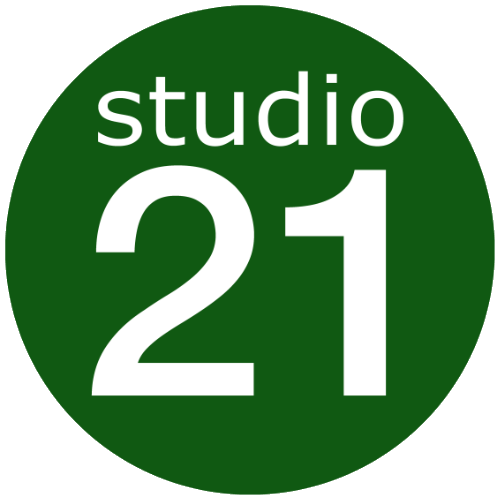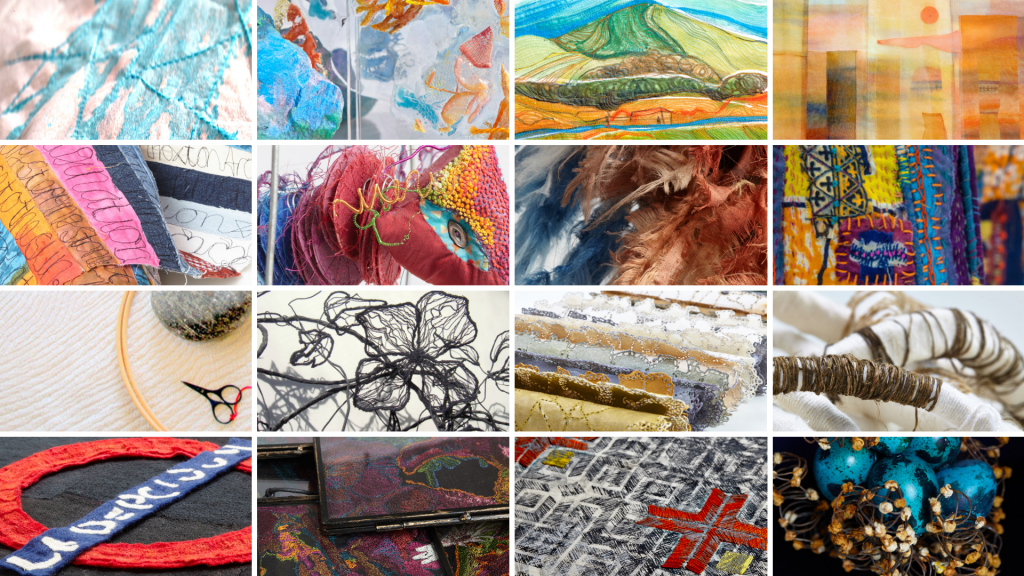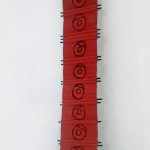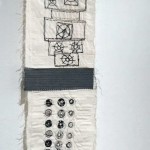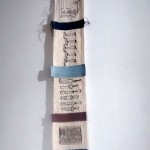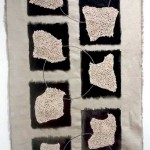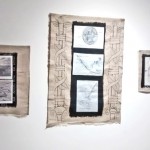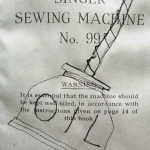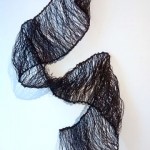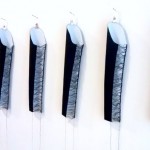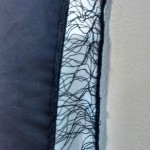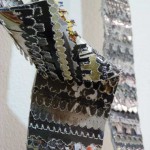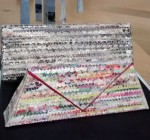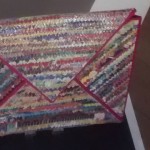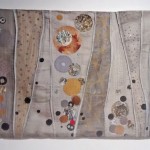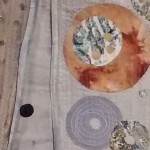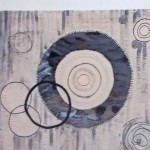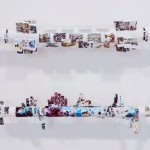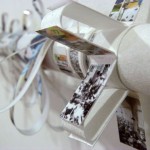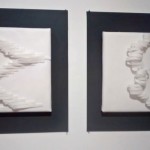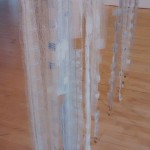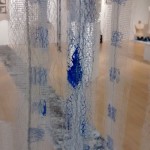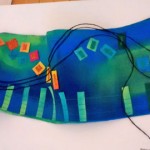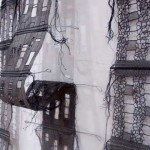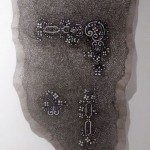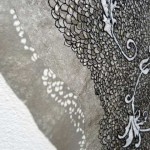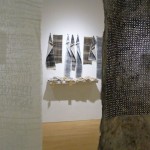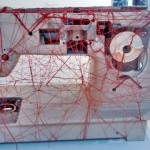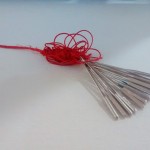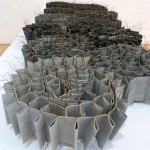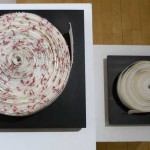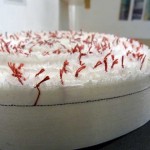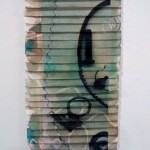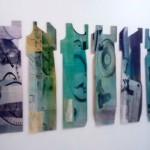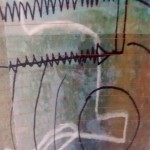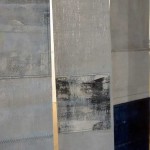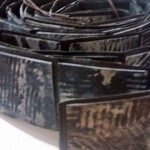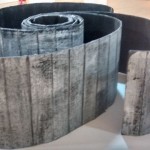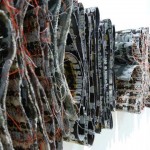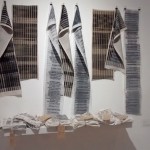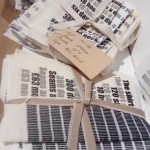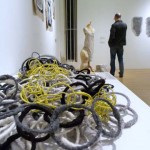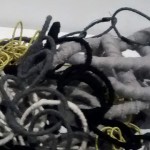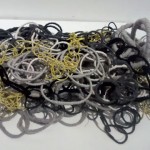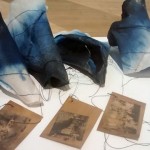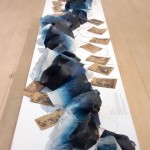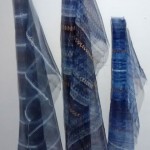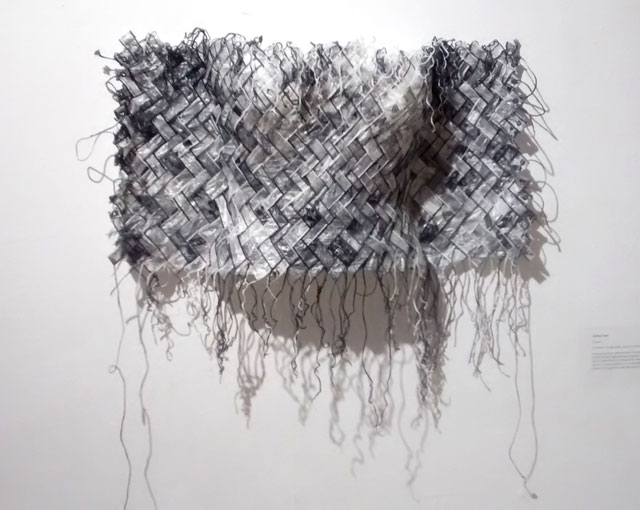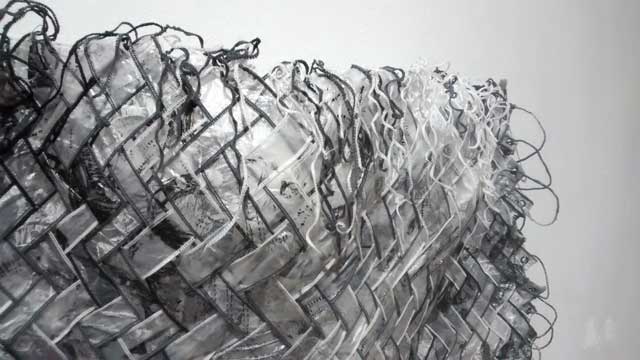The Iron Needlewomen
(Click here to return to overview of the project)
Susan Chapman
Repetition – Cogs – Stitch
Most of the pieces taken from the destruction of our sewing machine were cogs and wheels, screws, bolts and rivets. I use my machines in my work and enjoy the rhythm of the repetition of the movement to create the stitch.
Draw
As a child my relationship with the sewing machine was not a happy one. As a leftie, the hand cranked machine was beyond me. However now, with the electric sewing machine I regard drawing with the sewing machine to be my primary activity. Draw is the result of an exciting challenge to draw by machine daily, and create a stitched sketchbook.
Annette Collinge
Rhythm – Satisfaction – Tension
Knitting portrays the three elements of my response to the sewing machine. Garter stitch is knitted as a tension square, but the shape is distorted, reflecting problems with tension on the sewing machine. Knitting needles make a satisfying rhythmic sound reminiscent of the rhythm and satisfaction I derive from machine embroidery.
Pleasure
Pleasure is a response to old sewing machines, in particular the decoration in gold on their glossy, black structure. I own four old machines and have come across several others, which to me are things of beauty and historical interest, not to be compared with the functionality of modern machines.
Judy Drysdale
Interactive – In-between – Lines
A fascination of the sewing machine mechanism, the relationship between the movement of the bobbin and the reciprocal action of the piercing needle was the starting point for this project. What is occurring beneath the footplate during the machining process? I describe this as the “in-between, interactive lines”.
Mass Production
The invention of the sewing machine and its wider use from the 1850’s changed the working lives of seamstresses from cottage industry to mass production factories. Over the last century and a half there have been many improvements in factory conditions and vast developments in sewing machine technology, which has resulted now in the growth of a huge industry focused on the mass production of clothes.
Jill Flower
Monotonous-Excitement-Functional
The monotonous layering, stitching of paper and the drone of the machine led on to the excitement of discovering a strong paper fabric mimicking a reptile skin. The machine is generally regarded as functional; therefore I too, wished to design a practical and useful accessory: a selection of bags!
Feed Dogs
Feed Dogs represents the metal teeth of the machine and the movement of the material through the needle and presser foot. Pages from magazines are dismantled, deconstructed and re-laid with stitch creating a surprisingly strong fabric.
Anne Froggatt
Circles – Lines – Repetition
Connecting Circles: After looking at drawings and considering the components of the sewing machine, the shapes which dominated were the circles of the spools and cotton reels plus the repetitive straight stitch of the machine.
Back to Basic
The sewing machine is used by me in its basic form which is simple straight stitch. This piece uses the lines of stitch to anchor the circular shapes of the spools and bobbins. The eye travels across the work following the circles and up and down following the different simple stitches.
Linda Gleave
Piercing – Zig-Zag – Linear
As the sewing machine combines many actions that allow us to stitch, it seemed important to illustrate the outer and inner workings of the machine to represent the movement created by stitch patterns and the action of the shuttle.
Treadmill
Treadmill is the result of researching images of the exploitation of women in various factory settings down the decades and incorporated them into moving sculptures which interpret either the action of the needle or other sewing machine parts.
Marion Glover
Rhythm of Stitch Patterns – Comforting Sound
Engaging with the various stitch rhythms and sounds emanating from a working sewing machine these pieces explore the purring continuous tone of stitch and the bobbin whirr with the broken sounds of many different automatic stitch patterns and the ethereal nature of these quiet and fleeting sounds.
Graphic Sound
An alternative way of writing music known as Graphic Sound was developed in the 1970s which connects with the musical sounds of a sewing machine. This piece also reflects research into the work of leading machine embroiderers of the last 30 years, particularly the stunning colourful work of Christine Risley, tutor at Goldsmiths, who so influenced contemporary machine embroidery.
Samantha Harvey
Sam was on sabbatical for the first year of the project, so both her pieces relate to her part 2 research.
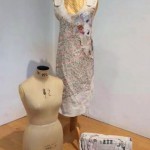
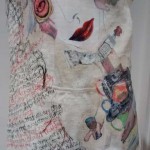
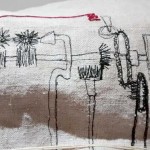
L’Enigma
As the first domestic appliance, the sewing machine required ingenious marketing to become successful. It was important to maintain the social pretence that women should not, indeed could not, use machines. As such the mechanics were hidden beneath beautifully ornate casing. Many women who sew actually find the mechanics intriguing and when contemplating this, the intrigue and weight of Man Ray’s L’Enigma d’Isodore Ducasse came to mind and L’Enigma evolved.
A Beauty Ritual of Orderliness
An extract by Mary Brooks Picken’s is available as an example of 50’s sexism. Reading the original text one realises that the basic tenet is actually sound: to ensure that your sewing time is rewarding, make sure that you give it time and space. The specific directives however are laughable in today’s context. This piece is worked on a simple apron, required to protect your best dress worn so that you were not “constantly fearful that a visitor will drop in or your husband come home” finding you “not look neatly put together”.
Liz Heywood
Broken – Change – Repetition
These pieces were made to symbolise the words chosen about the sewing machine. Broken referred to the abandoned machine dismantled at the beginning of the project. The drive belt which was an essential part of a working machine was used to show repetition and change which reflected the action of stitching. The change in appearance of the drive belts imitated the action of machining to transform a cloth.
Decals
These pieces were linked to the ornamentation on Singer sewing machines, specifically the decals used to embellish the appearance of the machines, especially those found on the early models and the vibrating shuttle machines which were produced in the 1880s.
Denise Jones
Repetition – Mass-Production – Binary
Two cloths reflecting on our preoccupation with the cultural body being industrious, hard working and ever producing. The heavy, dirty, mass industrial production processes of making sewing machines at the Singer factory in Clydebank: the repetitive casting of iron bodies. A start contrast to machine sewing: clean and free from the spillages of contamination, from oil and blood.
Red Clyde
A materialisation of the entanglement of human activity and object associated with the now closed Singer factory, Clydebank, Glasgow.
Debbie Lyddon
Repetition – Duration – Succession
Fold considers the relentless mechanical movements of the sewing machine: the way the needle punctures the fabric as it moves up and down, the action of the feed dogs and the of stop/start action of the machine. I stitched, folded, pierced with wire and rolled eleven, 12 metre strips of cloth to represent the fundamental processes of the machine.
Seam I: 20,000 Stitches – Seam II: 36 Metres
In 1860 Godey’s Lady’s Book reported that the sewing machine was the ‘Queen of Inventions’ and that a gentleman’s shirt required 20,620 stitches which at the rate of 35 stitches per minute took about fourteen hours and twenty six minutes to finish by hand. Operating a sewing machine at 3,000 stitches a minute; a seamstress could assemble a shirt in one hour sixteen minutes by machine’.
This work poses and answers two questions:
Seam I: 20,000 Stitches – How long does it takes to sew 20,000 stitches by hand? Result: 30 hours, 38 minutes;
Seam II: 36 Metres – How long does it take to sew the length of 20,000 hand sewn stiches (36 metres) by machine? Result: 29 minutes, 36 seconds
Sandra Meech
Layers – Connections – Time
I wanted to explore the connection between the drawings of machine parts from my sketchbook as they are assembled in slats to suggest layers. It did remind me of a tiered dress with crinolines made for me by my mother when I was a child.
Connecting Memories
This project has been a creative journey, full of family memories – my mother making our clothes, then later working with dress patterns. These long asymmetrical shapes represent all the clothes I’ve made over the years from the high school prom gown to my own wedding dress. The fabric originated from machine parts that were drawn and photographed to create sketchbook pages.
Mary Morris
Balance — Potential — Connection
On Line includes monoprints based on my sketchbook drawings of machine parts and also in response to the words balance — potential — connection. Paper monoprints were mounted on cloth and stitched to painted canvas and linen.
On Track
On Track is based on drawings made of the drive belt of a sewing machine. It was made by building up and scraping back many layers of paper and acrylic paint on primed canvas – a process that for me resembles the uses and repetitive actions of the sewing machine.
Amarjeet Nandhra
Utilitarian – Continuous – Time
Continuous explores the relationship between the garment industry and the words Utilitarian – Continuous – Time. Each folded canvas roll represents a block of time in the production of a garment and the continuous nature of this task. The materials used reflect the utilitarian nature of the industry.
The Shirt on your Back
The nature of this work explores the idea of the bundle system or piece work. Workers are paid based on the number of items processed per hour/per day. Each bundle contains 120 prints, and 6 bundles. This would be the total amount of shirts required to be produced over the course of 6 days.
Consuelo Simpson
Consuelo joined Studio 21 during the second year of the project, so her piece relates to part 2 research.
FortyFive days and Ten washes
Fast fashion both feeds and satisfies the desire of consumers in the industrialised world for access to affordable clothes reflecting ever- changing fashion trends. This piece references the interdependence of the fragmented supply chain of the fashion industry and the complex nature of sustainability.
Dawn Thorne
Without The Women
Without the Women is a work that recognises the labour force of sewing machinists in factories across continents. Women formed the backbone of these factories, working long and unforgiving hours. Without them the fashion trade would fall. The continuous journey of a bias form, reflect singular vertebrae, seen as individual workers, collectively forming the core.
Let Me Sew
Let Me Sew is an interactive work that uses mechanical process, to create movement. Home Sewing and the introduction of the Sewing Machine in homes made it possible for women to create their own garments from readily available patterns. Let me Sew demonstrates the typical women’s’ wardrobe of the 1950’s.
Anthea Vaal
Anthea joined Studio 21 during the second year of the project, so her piece relates to part 2 research.
Corset 1
Sewing machines have evolved dramatically since they were introduced into the underwear industry in the 1850s as have the fabrics used to create foundation garments. This reinterpreted corset is made from bias woven ribbons of printed, stitched, layered and overlocked translucent polythene sheets, with reference to past hand skills like cording and quilting.

